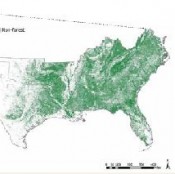Beyond Timber: New Economic Opportunities for Southern US Forests
The Southern US could permanently lose tens of millions of acres of forest to development over the next 30 years, which means the loss of ecosystem benefits, including timber, water purification, and recreation opportunities. The World Resources Institute (WRI) has identified some economic incentives that can help the South mitigate the loss of these benefits.

The Southern US could permanently lose tens of millions of acres of forest to development over the next 30 years, which means the loss of ecosystem benefits, including timber, water purification, and recreation opportunities. The World Resources Institute (WRI) has identified some economic incentives that can help the South mitigate the loss of these benefits.
1 February 2011 | Stretching more than 200 million acres from Texas to Virginia and from Kentucky to Florida, the forests of the southern United States provide billions of dollars worth of timber and other forest products each year as well as hundreds of thousands of jobs in the region. Though they comprise just two percent of the planet’s forest cover, they generate more pulp for paper by volume than any nation outside the United States. They also control erosion, ensure clean supplies of freshwater, and offer numerous hunting, hiking, and other recreational opportunities.
However, 31 million acres of these forests are expected to be lost to development between 1992 and 2040 — an area the size of North Carolina. Strategies are needed to halt this loss.
This month, the World Resources Institute (WRI), supported by Toyota, is launchinged the first in a new series of issue briefs that explore incentives for ensuring that southern US forests continue to supply not only timber, but also a number of other benefits — known as “ecosystem services” — that people depend upon. Among these additional services are water filtration, carbon sequestration, and recreation opportunities.
These services help support the local economy, but many will continue to be degraded and lost without conservation and sustainable management of the region’s forests. Fortunately, over the last few decades, ecologists and economists have developed mechanisms that both identify the economic value of these services and help finance their conservation.
WRI’s first brief, Keeping Forest as Forest, overviews a range of economic opportunities that are available to southern landowners and provides a foundation for later briefs in the series.
“We have a short window of opportunity to increase the conservation and sustainable management of large tracts of southern forests,” explains Todd Gartner, Senior Associate of Conservation Incentives and Markets at WRI. “In many ways, the next 20-30 years will shape the fate of these forests. There is a large generational transfer of ownership among families on the horizon, as well as a likely return of housing pressure.”
Yet there is hope. As Keeping Forest as Forest profiles, there are a variety of incentives for maintaining southern forests while addressing the threats they face, including:
- Market incentives such as markets for sustainable timber, payments for watershed protection, and recreational user fees;
- Fiscal incentives such as cost-share programs and tax deductions that help finance the expenses associated with reforestation, conservation, and sustainable forest management on private lands;
- Liability limitations that reduce liability risk to landowners for taking voluntary, proactive steps to protect or restore forests via prescribed burns, endangered species protection, and other actions;
- Land- use instruments such as conservation easements, working forest easements, and transferable development rights; and
- Education and capacity- building programs that ensure landowners have access to information about best forest management practices.
“Both corporate and family forest owners are increasingly interested in economic opportunities beyond just timber for their woodlands,” said Lee Thomas, Chairman and CEO of Rayonier, a real estate investment trust with landholdings in the South. “This and subsequent issue briefs should help southern landowners explore these opportunities in more detail.”
WRI has found that many of these incentives are currently underutilized in the region. Awareness of them is mixed. And some incentives such as markets for watershed protection are just emerging and therefore are relatively novel to most landowners.
What can be done to increase adoption of the most promising incentives? Each issue brief will explore this and related questions.
“We hope that WRI’s timely series will raise awareness about the incentive options available for conserving and sustainably managing southern forests for the future,” said Patricia Pineda, group vice president of philanthropy and the Toyota USA Foundation. “As always, Toyota remains committed to raising awareness of environmental issues of concern and is proud to sponsor WRI’s work as part of the company’s commitment to the Clinton Global Initiative.”
To access these briefs and to learn more about southern U.S. forests, visit www.SeeSouthernForests.org. Developed by WRI with support from Toyota, this interactive site provides a wide range of information about southern forests, including current and historic satellite images that allow users to zoom in on areas of interest, overlay maps showing selected forest features and drivers of change, historic forest photos, and case studies of innovative approaches for sustaining forests in the region.
If you would like hardcopies of each issue brief, please click here.
Additional resources
Please see our Reprint Guidelines for details on republishing our articles.

